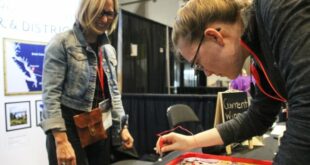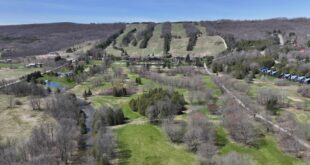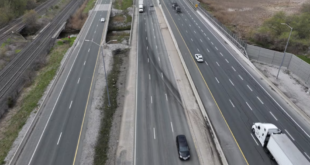As wildfire seasons get worse, some regions face a shortage of volunteer firefighters.

Summer 2023 in Canada has been marked by out-of-control fires from coast to coast to coast, making it the worst wildfire season on record. One line of defence against these worsening climate events is a network of volunteers that is shrinking each year, say fire chiefs.
According to a 2022 report from the Canadian Association of Fire Chiefs (CAFC), an estimated 90,000 out of 126,000 firefighters across the country are volunteers, making up over 70 per cent. Back in 2016, a similar census counted 156,000 volunteers.
This year, over 13.6 million hectares have burned in Canada as of Aug. 16, blowing far past the 10-year average of 2.2 million hectares, with more fires continuing to threaten parts of Northwest Territories and British Columbia.
With the shortage of firefighters making an impact from New Brunswick to N.W.T., we spoke to fire chiefs who discussed how volunteer firefighting works in Canada and ways they envision addressing these gaps.
What does a volunteer firefighter do?
Volunteer firefighters are typically on-call at municipal fire departments, answering calls for service in their region where structures are threatened.
While some on-call firefighters are truly volunteers — and not paid wages or expenses — others classified as volunteers may be paid wages, on-call time, honoraria or expenses, depending on the department.
Wildfires that originate in forested areas are handled by separate wildland teams that are hired and managed provincially. A Reuters report found about 5,500 wildland firefighters are employed across Canada. Municipal career and volunteer firefighters join the fight only when it encroaches on a populated area.
“The rural teams are more [made up of] volunteers,” said Brian Starkell, president of the Canadian Volunteer Fire Services Association and former fire chief in Nipawin, Sask. “They also have a full time job that they work at and usually it’s about half time that you’re dedicating towards firefighting and training.”
Increasingly, they are also called upon to respond to medical emergencies as well. The CAFC report showed out of the two million calls firefighters responded to last year, 44 per cent were medical emergencies.

How does training and volunteering work when you also have a day job?
The exact amount of training depends on the municipality, and according to Starkell, volunteers receive the same amount as career firefighters in the same department and it takes several years to complete.
“A lot of it is by correspondence and then there are scenarios that you have to do to pass the course, so it’s pretty intense,” he said.
Ken McMullen, chief of emergency services in Red Deer, Alta., and president of the Canadian Association of Fire Chiefs, said departments do not have enough younger people, in the 18 to 25 year age group, joining as volunteers in recent years.
Those who have jobs outside of volunteering take time off to respond, answering calls at a moment’s notice. McMullen and Starkell both said this system has mostly worked well so far.
“Where we’re seeing struggles right now is a fire season like this particular year, where people are gone for 30, 40, [or] 80 days at a time,” McMullen said, foreseeing challenges in the future. “It’s just not sustainable.”
The Assembly of First Nations is calling for an immediate increase in support for communities and individuals affected by the wildfires still raging across the country. AFN B.C. Regional Chief Terry Teegee and AFN Northwest Territories Regional Chief Gerarld Antoine tell CBC’s Power & Politics what their communities need.
Why is there a shortage of volunteer firefighters?
Retirement, family commitments, and people moving to different municipalities that may have less need of firefighting, are all reasons the fire chiefs cited, along with slower uptake from young people.
“When we lose firefighters, we’re typically aging out, which means in a lot of municipalities, volunteers are not covered by their insurance policy after the age of 60,” McMullen said. “That population that holds a large group of volunteer firefighters in Canada, we’re starting to lose at that end, and we can’t recruit fast enough at the other end.”
Both discussed an urgent need for better federal and municipal support and compensation for firefighters, to help recruit with wildfire seasons worsening.
What solutions are on the table?
The national associations for volunteer firefighters, fire chiefs, and search and rescue members, have all lobbied to the federal government to increase the tax credit for volunteering as a firefighter or search and rescue member. It currently stands at $3,000, and they are seeking an increase to $10,000.
The CAFC has made three other recommendations as well, according to McMullen: provide volunteer firefighters with better mental health support, hire a national fire advisor to coordinate emergency teams at the federal level, and bring back a program that used to give fire departments more training and equipment.
“The joint emergency preparedness plan allowed fire departments to apply for specialty training and equipment in order to support different things that we don’t do regularly — and wildfire is not something that municipal firefighters do on a regular occurrence,” McMullen said. “That ended in 2013, and we’ve advocated for that to come back.”
Some in B.C. have floated the idea of having a national wildfire-fighting force in Canada, following models like Australia. Currently the Canadian Interagency Forest Fire Centre helps provinces co-ordinate wildfire response and training.
According to Starkell, municipalities should be funding fire departments better.
“A lot of firefighters are raising funds themselves in their organizations to help buy equipment,” he said. “The RCMP don’t raise money to buy bullets, so the firefighters shouldn’t have to raise money to buy equipment.”
Depending on the municipality, a volunteer firefighter gets paid either hourly or with an annual cheque, according to Starkell.
Neither he nor McMullen could say how much volunteers are paid on average.
“The biggest thing that we can say is that we’re helping people,” Starkell said, echoing a sense of pride in the work. “We don’t know these folks, they’re complete strangers, but we’re out helping them at the worst time of their lives.”
ABOUT THE AUTHOR
Brishti Basu is a senior writer with CBCNews.ca based in Victoria. Before joining CBC, her in-depth coverage of health care, housing and sexual violence at Capital Daily was nominated for several national and provincial journalism awards. She was deputy editor at New Canadian Media and has been a freelance journalist for numerous publications including National Geographic, VICE, The Tyee, and The Narwhal. Send story tips to brishti.basu@cbc.ca.
*****
Credit belongs to : www.cbc.ca
 Atin Ito First Filipino Community Newspaper in Ontario
Atin Ito First Filipino Community Newspaper in Ontario






